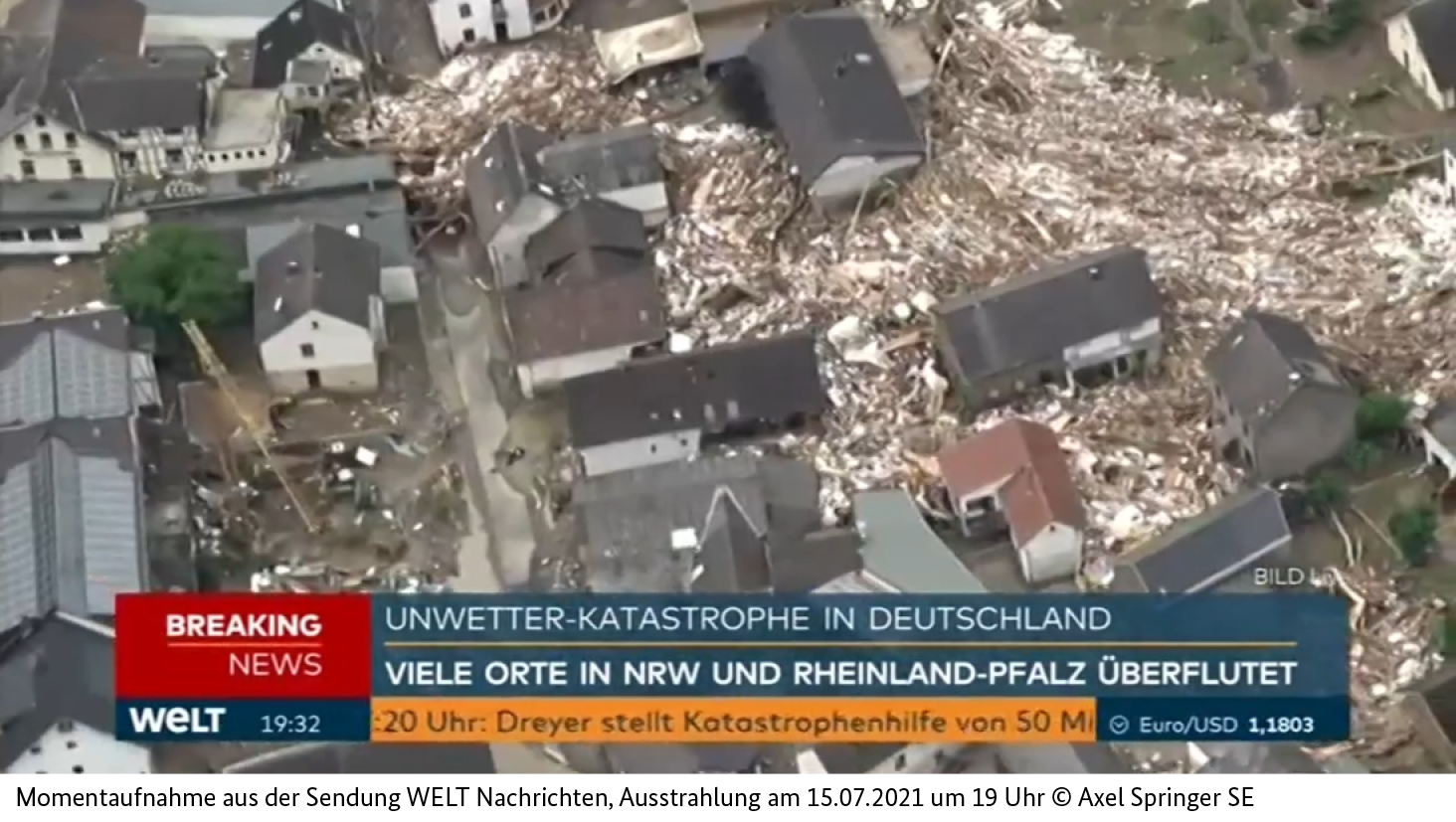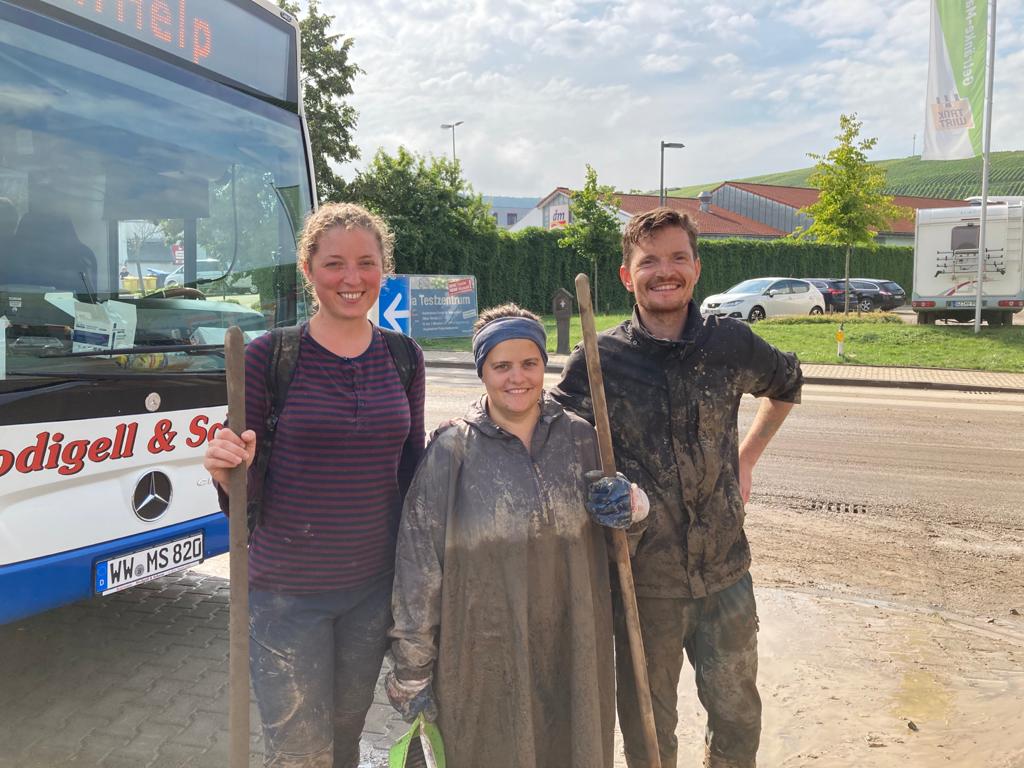14.07.2023 | Reportage
Spontaneous aid in Ahrtal
Fabian Menzen is one of thousands of spontaneous helpers who were on site in the Ahr region in summer 2021. He lent a hand when the need was greatest after the flood disaster. Today, he talks about his experiences as a spontaneous helper.
Cars being swept away by masses of water as if they were children’s toys. Bridge piers buckling like matchsticks under the pressure of the floating debris. A field of rubble where charming, intact houses once stood. But worst of all: the desperate voices of people who have lost everything in just a few hours. The images of the flood disaster, which dominated the media from July 14, 2021, seem surreal, apocalyptic, incomprehensible. Over 180 people died in the flood of the century in Rhineland-Palatinate and North Rhine-Westphalia.

The biggest disaster since World War II
What triggered the disaster? In the summer of 2021, extreme storms raged across Germany. Massive flooding and flash floods occurred. The Ahr valley was particularly badly affected with 135 deaths. An analysis by the German Weather Service shows that more rain fell on Wednesday, July 14 alone than in the entire month. The water had nowhere to go in the narrow Ahr valley. It destroyed the entire infrastructure of the region: the worst disaster since the end of the Second World War. The complete devastation of the Ahr Valley meant that many people in Germany wanted to help – whether by donating money, goods or in person. Fabian Menzen, 42, a product manager from Bonn, is one of the many thousands of people who decided to help spontaneously on the ground.
Standing by and watching was not an option
Like so many others, he sat in front of the television on that July evening and watched in shock as the disaster unfolded less than 25 kilometers from his home. He was deeply moved, his thoughts revolving around the victims of the flood and their families. His worries also had a very personal background: some of his acquaintances live in the flood area, and at first it was uncertain whether they would be okay. But despite the images that reached us on all channels at the time, Fabian says he couldn’t get an idea of what it was really like on the spot at the time. But one thing was immediately clear to him: he couldn’t just sit here and do nothing, he had to help. And that was relatively easy at first. Through direct contact with the people in the flood area, he and numerous friends immediately knew where they could lend a hand. “We knew where we had to go, what needed to be done and what materials were needed,” says Fabian, describing his initial efforts. But in the days that followed, it became increasingly difficult for him to find out where his help was most likely to be needed. Another obstacle: in many areas, access was restricted. People were asked not to drive into the flood area on their own so as not to clog up the access routes.
The “helper shuttle”: spontaneous help, spontaneously coordinated
It was at this point that Fabian became aware of the “Helfer-Shuttle” initiative. The “Helfer-Shuttle” team was founded on July 17 by two entrepreneurs from the Ahr valley. Marc Ulrich and Thomas Pütz had set themselves the task of bringing together the need for help on the one hand and the offer of volunteers on the other. The project also provided the necessary infrastructure and logistics and communicated effectively via social media. “The team managed and coordinated a mammoth task in a very short space of time,” says Fabian. This left the volunteers free to concentrate on the essentials: helping others. They could also be sure that their commitment would reach exactly where it was needed. And so Fabian arrived at the meeting point in the industrial park in Grafschaft-Ringen at around 9 a.m. on a Tuesday with hundreds of other volunteers. From there, thousands of helpers were brought to specific locations in the Ahr valley every day.

In action against the mud
The “standard equipment” of the volunteers? Buckets, brooms, shovels, gloves and rubber boots. When it came to the latter, Fabian quickly realized: “My rubber boots are more for sailing. They quickly reached their limits in the conditions.” Fortunately, there were also numerous donations in kind: Fabian was provided with more robust rubber boots with a metal insole early on – he was thus better able to ward off cuts and stabs. Fabian spent a total of eight days helping out in the Ahr valley, spending most of his time fighting against the omnipresent mud. Sometimes he also helped to core or prepare severely damaged houses. “Once we were at the mouth of the Ahr and collected what felt like thousands of drinks crates and bottles from the banks.”
Help comes first: Time off work possible
He was usually in the Ahr valley at the weekend to help. Every now and then, he has taken up his employer’s offer to take time off work. And Fabian’s employer was no exception: in the first days and weeks after the disaster, many local private companies and authorities gave their employees time off to help spontaneously in the flood areas, for example through special leave. Anyone involved in the volunteer fire department or THW can rely on a statutory regulation: employers must give volunteers time off during working hours if they are alerted. It is also specified that no professional disadvantages may arise in such a case. The hours do not have to be made up, nor does leave have to be taken for the deployment. In the case of the THW, a federal law regulates the details, while the respective state law on fire protection applies to volunteer fire departments. Helpers from the white organizations (the German Life Saving Association, the German Red Cross, Johanniter-Unfall-Hilfe, Arbeiter-Samariter-Bund Deutschland e.V., Malteser Hilfsdienst) are also released from their duties when a disaster is declared by the district or independent city. Further information can be found in the magazine article on equal opportunities for volunteers.”
“An impressive experience”
The conclusion of his commitment? “It felt good to be active and to be able to help. It made me feel a little less powerless during the disaster.” Fabian also felt how important his commitment and that of others was for those affected on the ground – as a signal that people are not alone in the disaster. The help was also able to provide a little comfort. It also created a great sense of community: “The solidarity among the people at that time was indescribable. It didn’t matter where someone came from or what they did. Everyone did what they could.”
Today, Fabian is certain that he would volunteer spontaneously again at any time. At the same time, he emphasizes that it is important to assess your strengths and weaknesses well. After all, you often don’t know exactly what to expect on site. Fabian was impressed by both the spontaneous commitment of the “helper shuttle” and the professional help: “The efforts of the police, fire department, German Armed Forces, THW, DRK and many others were more than impressive.” But it was the reaction of the people on site that left the most lasting impression on him: “How many of those affected dealt with the situation in a calm and orderly manner despite the loss and despair – that was an impressive experience.”